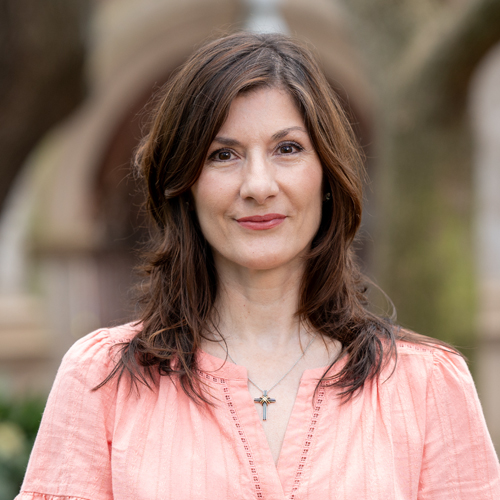
Carmen M Grace
Associate Professor of Spanish
Education
Bachelor’s degree From Universidad Complutense de Madrid, Spain
Master and PhD from The Ohio State University
Research Interests
Carmen Grace's research interests are the classical rhetorical concepts that inform the treatises on preaching and their theoretical confluences with the art of painting in the Baroque era. She is also interested in the iconography of popular religious figures (such as Mary Magdalene) and their decisive impact on Spanish society's devotion during the Counter-Reformation.
Courses Taught
Medieval and Early-Modern Spanish Literature: short narrative, poetry, and plays.
History, culture, art, and festivities of the Iberian Peninsula from Prehistory to 17th century.
SPAN 630 – Love and Honor: no Solution to the Conflict?
SPAN 333 – The Cultural Origins of the Iberian Peninsula: Conquest, Celebrations, and Art.
SPAN FYE 202 – Global Perspectives: Madrid and Andalucía.
SPAN 495 (Capstone) – Culture, Art, and Architecture in the Baroque of the Spanish Empire.
SPAN 490 – LCWA Signature Series: Mythical and Literary Seville in the Baroque.
SPAN 367 – Hispanic Lyric Poetry: Emergence and Evolution (11th 17th centuries).
SPAN 333 – Art, politics, and festivities in the Old-Iberian Peninsula.
SPAN 493 – Honor and Women in Golden Age Texts.
SPAN 493 – Narrative Fiction in Spanish Golden Age.
SPAN 333 – Spain: From its Beginnings in History to the Rise and Fall of its Early Modern Empire.
SPAN 630 – Spanish Identity through Golden Age Literature
SPAN 367 - A Feminine Lense: Exploring Women in Golden Age Literature.
Publications
“El atractivo de la penitencia: la figura de la Magdalena en la Contrarreforma”. Manuel de Nájera, decano de predicadores. Oratoria sagrada y espacios de poder en la Real Capilla del siglo XVII, edited by Jaume Garau and Francisco José García Pérez, Berlin, Boston: De Gruyter, 2024, pp. 109-124. DOI: https://doi.org/10.1515/9783110789447-006
“Encuentros retóricos en las artes: La pintura y la predicación áureas.” eHumanista 42 (2019): 55-65. DOI: https://www.ehumanista.ucsb.edu/volumes/42
“El púlpito barroco: devoción espectacular” en Espacios de encuentro e identidad. Actas del XXXV Congreso Internacional de ALDEEU. Edición de Marina Martín. Nueva York, 2019, pp. 147-164.
“Sobre la predicación culta en el Siglo de Oro: polémicas y retóricas cristianas.” Bulletin of Hispanic Studies, 93-9 (2016): 963–980. DOI: http://dx.doi.org/10.3828/bhs.2016.60.
“Prototipos simbólicos cristianos: retórica y performance en los sermones de la España contrarreformista.” Hispanófila, 173, 2015, pp. 37-52.
“Exequias reales en la Contrarreforma: doctrina católica y Barroco en el sermón funeral de fray Alonso de Cabrera (1549?–1598) por la muerte de Felipe II.” Bulletin of Spanish Studies: Hispanic Studies and Researches on Spain, Portugal and Latin America, 92.1 (2015): 25-49. DOI: http://dx.doi.org/10.1080/14753820.2014.942550.
“El púlpito del siglo XVI: una respuesta ascético-barroca contra la injusticia social.” Monographic volumen Literatura y poder. Crítica Hispánica (2011): 127-147.
“El peligro de la ignorancia: la herejía en la sociedad española de finales del siglo XVI.” Rondas Literarias de Pittsburgh Gregorio Cervantes Martín, ed. (Pittsburgh: Duquesne University, Department of Modern Languages, 2010).
“El concepto de la muerte a finales del siglo XVI: Felipe II, paradigma del bien morir.” Rondas Literarias de Pittsburgh, Gregorio Cervantes Martín, ed. (Pittsburgh: Duquesne University, Department of Modern Languages, 2009), 137-147.
“Políticos y poderosos en los sermones de Alonso de Cabrera (1549-1598): el uso del púlpito como vehículo regulador de la unidad de España.” Rondas Literarias de Pittsburgh, Gregorio Cervantes Martín, ed. (Pittsburgh: Duquesne University, Department of Modern Languages, 2008).